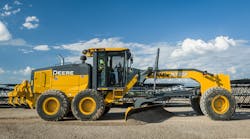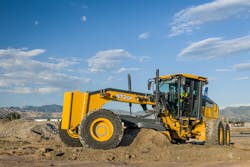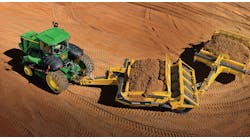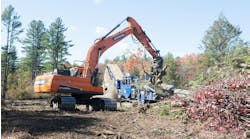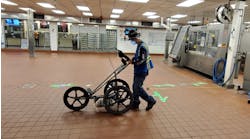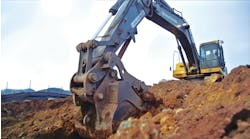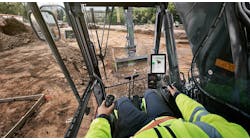Motor graders are a vital piece of equipment on any road-building job site, not only for finish grading but for site clearing as well, according to Matt Goedert, solutions marketing manager, roadbuilding for John Deere. “Motor graders have the highest horsepower in their size class to give operators the most performance out of their machines when they need it,” says Goedert.
"In the beginning stages of a road-building project, graders are often the chosen tool to clear the vegetation and topsoil when prepping the site. The quick travel speeds and wide blade of a motor grader make it an efficient machine for covering a large area."
Features such as 6-wheel drive on John Deere’s 622, 672, 772, and 872 models add additional versatility to road building sites. Six-wheel-drive enables increased performance in poor ground conditions and allows operators to return to the job sooner after inclement weather where a traditional tandem drive grader may not be able to work. Additionally, a six-wheel drive is excellent for slope work and ditches and in some cases can replace the need for a second machine like a crawler dozer because of the grader’s ability to handle the slopes.
"On a road-building site, efficiency is critical to keep the job moving and to complete the job on time or hopefully well before the deadline. Along with an endless amount of upfront planning, the efficiency of the equipment and its operator plays a large part in maintaining profitability throughout the job. Contractors face uncertainties, obstacles, and conditions that are out of their control every day. Having equipment that is efficient, reliable, and easy for the operator to use makes a very big difference.
“Load capacity is the biggest driving factor in today's scraper purchasing decision. They want as much capacity they can get while maintaining floatation and not overloading the power unit. Durability is also essential and that’s why Deere has such a great reputation. Daily maintenance is important but since scrapers only need grease is probably the smallest factor,” adds Justin Steger solutions marketing manager, site Development and underground for John Deere.
Autoload technology is optional on our John Deere scraper pans. Autoload helps operators load the scraper to its fullest capacity every cut. It allows novice and experienced operators to be more consistent and productive while operating John Deere tractors and scrapers. With the touch of a button, operators maximize productivity and efficiency even if they have never operated tractors and scrapers.
“Autoload provides reduced labor cost and reduced training time to bring operators up to full productivity," says Steger. "This means you will obtain more consistent yards per cycle, per hour, and day. All of this adds up to both increased ease of operation as well as reduced operator fatigue."
Goedert explains that automation features on John Deere graders improve efficiency, accuracy, and simplify machine operation, which benefits both new and experienced operators. What started with features like cross-slope and return-to-straight have evolved into SmartGrade mast-less grade control and other advanced automation features.
Optional on GP models and standard with SmartGrade are four automation features: Auto-Articulation, Blade Flip, Machine Presets, and Auto-Pass. Auto-Articulation combines front steering and rear articulation while blade flip, a Deere exclusive, allows the operator to automatically rotate the blade to a set position without holding the control at the end of a pass.
"Machine Presets, another Deere exclusive, allows the operator to activate multiple pre-set functions by pressing a single button,” adds Goedert. “Lastly, Auto-Pass allows the operator to raise and rotate the blade at the end of a grading pass with the press of a button. The operator can also lower the blade and turn on the automatics of SmartGrade at the start of a grading pass with the press of a button. This type of automation reduces the number of controls operators need to use to complete common tasks. These features simplify operation, reduce fatigue, and improve accuracy.”
John Deere currently offers eight models of motor graders: four tandem drive models (620, 670, 770, 870) and four 6-wheel drive models (622, 672, 772, 872). All eight models are configured with a standard steering wheel and can be equipped with John Deere’s Grade Pro option. John Deere's Grade Pro (GP) option comes standard with cross-slope and choice of either fingertip or joystick EH controls.
Automated cross-slope simplifies holding a consistent slope by reducing operation to a single lever while the system automatically controls the opposite side to maintain the desired cross slope. Cross-slope not only helps new operators get up to speed quickly but is a very convenient tool for veteran operators to use on road-building sites as well.
John Deere was first to market with mast-less 3D grade control on motor graders, they named SmartGrade. SmartGrade is available on all 8 models of John Deere Motor Graders. SmartGrade also supports more advanced systems such as Topcon mmGPS and LPS systems, in which sensors mount to the top of the cab so the machine can remain mast-less.
Whether it's using cross-slope or a 3D fully automated system, contractors see a return on the investment as this technology improves productivity and efficiency by enabling operators to get to grade faster with greater accuracy. To simplify maintenance, John Deere graders feature ground-level maintenance, grouped daily service points, and filter banks that utilize all vertical spin-on filters.
John Deere motor graders now feature an optional Premium Circle that improves performance and efficiency while reducing maintenance costs and downtime. The Premium Circle replaces the circle-wear inserts with a sealed bearing and pinion that only requires greasing every 500 hours and provides 40% more circle torque and 15% more speed over the standard circle.
To ensure smooth operation and shifting under loads event-based shifting determines the optimum shift time when a new gear is selected to provide smooth transmission shifts. Auto-Shift automatically shifts between gears 4-8 depending on where the shift lever is positioned. John Deere’s latest transmission option, Auto-Shift PLUS, includes all the benefits of Auto-Shift while also eliminating the need to use the inching pedal or clutch.
This feature allows the operator to grade around obstacles without having to continuously engage the inching pedal or worry about stalling the machine. Operators can now control machine movement, from full stop to transport and grading speeds, using only the throttle and brake.
Another manufacturer of graders is New Holland Construction. New Holland Construction offers six models of graders, ranging from 76 horsepower to 205 horsepower. All six models come with a variable-horsepower option and with a heavy-duty main frame. These graders can roll heavy materials away with no effort. New Holland Construction graders also feature cabins that provide exceptional visibility.
With the demand for more speed and efficiency on job sites comes an additional call for more scrapers. Attached to tractors or similar purpose vehicles, the scrapers are units that can be used for a variety of applications, such as scraping and removing dirt, gravel, or any other unwanted material from the surface. The main reason for the increase in the sales of towed scrapers is their lower costs when compared with self-propelled scrapers. One of the most common uses of scrapers is on highways.
Caterpillar offers 10 different graders, ranging from 125 horsepower to a huge 500 horsepower. Out of the 10 graders this brand manufactures, the one that is very popular around the world is the 140H. It features a large displacement engine and has 165 horsepower, with the ability to reach 185 horsepower with a variable-horsepower option. The CAT 140H includes many unique features that allow the operators to reach the toughest spots. With 8 forward and 6 reverse speeds, the operators can easily find the right gear for each job.
The five new Caterpillar scrapers are also very popular in the construction and agricultural industry. They have been upgraded significantly when compared with their predecessors. For example, all five models feature a new operator station and electro-hydraulic controls that significantly increase the productivity and operator’s comfort. With a single joystick in place of the old three control levers, these five Caterpillar scrapers offer a simplified operation and a very unique experience to the operators.
Caterpillar's scrapers come in three different configurations: self-loaders, twin engines and open bowls. Many new electronics have successfully replaced the old mechanical control system. The CAT scrapers come with an electronic power unit, so their engines feature an electronic control module that controls the fuel injection timing and pressure. The control module monitors many inputs of the scrapers, ensuring accurate fuel injection timing and pressure for maximized efficiency.
Terex offers one model of scraper, the S17E. It is an elevating scraper with 285 horsepower. As with most scrapers, the S17E comes with an electronically-managed engine for increased torque and power and an electronically controlled transmission that provides 8 speeds. Switching between gears is very easy. The reversible elevators feature two speeds: a general dirt-moving mode and a finish dirt-moving mode.
The Latest Technology Reaches Scrapers
The last 20 years have been a renaissance of sorts for Ashland Industries. The convergence of laser and GPS technologies in land leveling has brought about a surge in demand for Ashland scrapers and new water management regulations have steered farmers back into the one solution that can bring their land into compliance—the scraper.
The cat-and-mouse game between high horsepower tractors and high-capacity scrapers continues to play on as horsepower is starting to exceed 700 hp. Ashland Industries, through its partnership with Case IH, has focused on producing products that maximize productive earth moving efficiencies while preserving the integrity of the customers' biggest investment, their tractor.
Each scraper is engineered to optimize the productive output of a set horsepower range of tractors.
The firm always tries to live its motto: Do More. With all the stresses and setbacks of the last year and a half, perhaps such a mantra has taken on even more significance.
For the most part, operators may stick with a grader as the best investment for surface leveling. Scrapers however are coming into play as walls. Demand and the sales of the latter have increased in recent years. The idea that graders may work best due to their speed and power may be hard to overcome. In the case of a small operator, the equipment available on a small scale basis sometimes works for grading as well.
Scrapers Converted to Do the Work
Nelson EZ Pull, which constructs direct-mount towed scrapers to meet the needs of large farm operators and earth-moving contractors. Typically, they rebuild 39-yard Cat scrapers, according to owner Clifford Nelson, in Comstock, MN, close to the Fargo Moorehead metropolitan area. “When we do this rebuilding, they are just like new,” explains Nelson. “The scrapers can be placed on articulated haul trucks. We have done this for farm equipment for years and for contractors as well.
“In the past, we specialized in converting industrial-grade scrapers such as Fiat-Allis and Allis-Chalmers, Caterpillar and LeTourneau into direct-mount pull-type scrapers between 18 cubic yards and 27 cubic years. Now we are offering the conversion of larger units up to 30 and 35 cubic yards,” said Nelson. These scrapers can be pulled on tractors too.
“Because we modify heavy-duty scrapers such as the Allis-Chalmers 460, our machines can unload the toughest loads, with the gate rising to a position about three feet above the top of the bowl, providing unrestricted ejection capabilities and with excellent hydraulics.”
These scrapers do not get clogged up with mud, sod or other materials. Sod is dumped with ease because blade elevation capabilities provide optimum ground clearance. At the customer's request, they also can add two tires to the rear, which improves floatation, eliminates rocking and provides better operation in wet or soft-earth areas.
Manufacturing takes place in Comstock, Minnesota. The company plans on expanding its product line to reach earth-moving contractors who need a dependable and efficient scraper for site preparation and road building, as well as to farm operators for earth-leveling and ditching.
The units have the advantage over four-wheel or dolly scrapers, as well as motor-scrapers. “Because the weight is directly on the axle as the weight increases, so does the traction,” adds Nelson. “The scraper can be filled even under wet conditions and wheel slippage is greatly reduced. Because the scraper's front wheels are gone, there is less rolling resistance and a driver can see how deep the blade is cutting. Directly mounted, it can be easily backed into hard-to-reach areas.”
Reshaping a Growing City for 70 Years
At the other end of the construction spectrum, Strange Brothers, in Taylors, SC has long been a full-service construction company dealing with anything to do with site preparation. This, from land clearing to asphalt paving and all types of projects in between. Predominantly their equipment is Caterpillar, with a few Komatsu pieces as well as Ingersoll-Rand rollers.
“We do everything possible before you go vertical,” explains Preston Baynes, project manager with Strange Brothers.
“A big part of our success comes, I think, from our versatility in moving everything from a half-million yards of dirt down to 5,000 yards. Don't put yourself in a box has been our mantra. We won't turn down a fancy dog house or an $11 million high school.”
On nearly all their jobs a bulldozer will be used, some type of equipment with GPS onboard. Baynes contends that though not every job is the same, they all have similar characteristics. “All projects have challenges. Our versatility allows us to do them all with some 150 different pieces of equipment—including over 14 scrapers. These are a paddle, pan, and actual scraper machines. We can move pan dirt, dirt with track hoes and with off-road trucks all at the same time.
“You want scrapers to run as effectively and efficiently as possible. Plus, we do compete with industries where the work perhaps may not be as challenging. This makes staffing—as with scores of other businesses today—a real challenge. Caterpillar has simulation exercises for those learning the use of the scrapers and graders, easing doubts for those coming into these work projects.
“Our equipment and our jobs speak for themselves. Yet it remains tough to hire a younger generation to move into this line of work. They do their research. But it's difficult to get them to come with you if the equipment isn't up to standards, doesn't have air conditioning or the very latest technology. If you don't set standards, it's hard to keep pace with the workforce. If the older fleet is not being maintained or updated with new parts your company, in turn, does not have that calling card."
